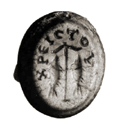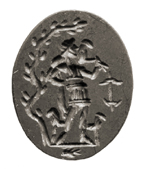
 |
Freethought & Rationalism ArchiveThe archives are read only. |
|
|
#281 | ||||||||||
|
Contributor
Join Date: Mar 2006
Location: Falls Creek, Oz.
Posts: 11,192
|
Quote:
1) The chi-rho monogram of Christ. (from Munich, Christian Schmidt collection. Red jasper in silver ring.) The chi-rho monogram AFAIK appears on the coinage of BCE Egypt and as such pre-dates christianity, so I have not included this image on the basis that I need not explian it. Since it cannot be argued that the image is unambiguously intended to be "christian" on the basis of the chi-rho. 2) IHCOY XPICTOY, "of Jesus Christ". (Private collection. Red jasper, 13 x 10 mm., in silver ring.)  (3) The acrostic IXQYC. (Private collection. Banded agate, 13 x 10 mm.)  and from .... Quote:
(4) Two fish flank an anchor, CREICTOU, "of Christ". (Berlin, inv. J.9396. Nicolo, 13 x 10 mm.)  (5) The Good Shepherd. An anchor is in the field and a fish in the exergue. (Oxford (Fortnum 89). Red jasper, 17 x 14 mm.)  Similarly, we have been through the "good shepherd" and the argument that the good shepherd was a pagan motif implies this class of image cannot be used to provide an unambiguous citation in express confirmation of the postulate that we have historical prenicene christians - because of this amulet. This leaves us with the items 2, 3 and 4, and the following questions: How were these amulets dated? Who dated these amulets and when and where? Who were these amulets obtained from? How much was paid for the amulets? Who paid the money, and to whom was it paid? Where were they found? What is their history of provenance? A separate thread of questions would relate to the text. What is the earliest recorded appearance of "Jesus" other than via the nomina sacra? What is the earliest recorded appearance of "Christ" other than via the nomina sacra? What is the earliest recorded appearance of "Jesus Christ" other than via the nomina sacra? How does this fit with the text on these amulets? What alternative translations exist? There are probably a whole host of other questions as well. I would appreciate some sort of acknowledgement that you see these questions as being valid. I think they are. Do you? Quote:
Am I supposed to "believe" in a (pre-certified) HJ? Quote:
At Dura there is neither claimed to be a christian church or christian church-house. It is specifically described as a house-church on the basis that it is just a normal run of the mill suburbia box made out of ticky-tacky that is suspected of being representative of "christian occupancy" by an analysis of the art work, and the grafitti associated with this artwork, on the interior walls of the building, under the strict proviso (as claimed) that the interior of the house was inaccessible for the period from 252 CE (wall collapse at Dura) and 1921 CE (discovery). Quote:
Quote:
Think Historical integrity and authenticity. By this I mean a global picture of all the references in the literary and the non-literary remains (of all NT "history"), specifically archaeology and all its associated sciences. We have two options: 1) There is a small amount of discernible historical integrity to "early christianity". 2) There is no amount of discernible historical integrity to "early christianity". The former option has been argued quite successfully for a long time now, by various historical parties with various agendas. The latter option as far as I know has not been argued in a specific fashion. I see that this second option should be explored. Quote:
Quote:
Successful military commanders often exploit many resources that they themselves personally may have no direct experience in, and know when and how to delegate projects as myriad threads towards a common goal. The Boss will stand up and take credit for the work that his "people" have done, whether this is his army, or his engineers, or his scribes. The Lane-Fox analysis of Constantine's Oration to the Saints, for example, has the Boss saying the following .... The Boss was the front man. Eusebius was in the back-office. Best wishes, Pete Brown |
||||||||||
|
|
|
|
#282 | |||
|
Contributor
Join Date: Mar 2006
Location: Falls Creek, Oz.
Posts: 11,192
|
Quote:
Basilica of the Holy Apostles, Constantinople Basilica of St. Paul Outside the Walls, Rome Basilica of St. Peter, Vatican Valley, Rome Basilica of St. Lorenzo, Rome Basilica of St. Sebastiano Basilica of St. Marcellino Basilica of St. Pietro Basilica of St. John, Laterano (over barracks of Maxentius' soldiers) Basilica of St. Maxentius Basilica of Santa Sophia Basilica of St. Constantine, Rome  Another consideration is the power and control exerted by the chrysargyron. Quote:
Best wishes Pete Brown |
|||
|
|
|
|
#283 | |
|
Veteran Member
Join Date: Nov 2007
Location: Chicago, IL
Posts: 3,058
|
Quote:
Given the certainty with which your hold your views that these are (or are most like all fakes, or are really to be read/interpreted in ways other than the ways qualified historians read/interpret them, you should have researched these questions -- and have come up with indisputable and evidenced based answers to then already. Why were you unaware of them prior to this? And why are you asking others to do your homework for you? Jeffrey |
|
|
|
|
|
#284 | ||||
|
Contributor
Join Date: Mar 2006
Location: Falls Creek, Oz.
Posts: 11,192
|
Quote:
What is the earliest recorded appearance of "Jesus" other than via the nomina sacra? What is the earliest recorded appearance of "Christ" other than via the nomina sacra? What is the earliest recorded appearance of "Jesus Christ" other than via the nomina sacra? How does this fit with the text on these amulets? What alternative translations exist? Jeffrey, If the name of your man Jesus H is here supposed to be inscribed in full on this holy relic, is this not the oldest exploded form of the nomina sacra Jesus H? Isn't this rather strange? Quote:
A study of the actual cited known forgery of relics in these almost 1700 years would provide an interesting statistic on where to place the onus of proof when discussing citations which are to be presented as authentic. Authenticity has been presumed but not established. There is a difference Jeffrey. Quote:
Do you have a favourite "holy relic"? Is it "Dura-Europa" too? Best wishes, Pete Brown |
||||
|
|
|
|
#285 | ||
|
Veteran Member
Join Date: Sep 2004
Location: Birmingham UK
Posts: 4,876
|
Quote:
Possibly you were confused because I cited the ANF from Roger's web site http://www.tertullian.org/ . Andrew Criddle |
||
|
|
|
|
#286 |
|
Contributor
Join Date: Mar 2004
Location: Dallas, TX
Posts: 11,525
|
|
|
|
|
|
#287 | |||
|
Veteran Member
Join Date: Sep 2004
Location: Birmingham UK
Posts: 4,876
|
Quote:
The Acts of Justin's Martyrdom exists in three forms. The Short Middle and Long versions (See Musurillo The Acts of the Christian Martyrs) The Long version is pretty obviously a later embellished version but it is disputed whether the Short or Middle Version is the nearest to the original. The citation I gave was to the Middle version found in most manuscripts including the oldest. The ending here reads Quote:
Quote:
Andrew Criddle |
|||
|
|
|
|
#288 | |
|
Contributor
Join Date: Mar 2006
Location: Falls Creek, Oz.
Posts: 11,192
|
Quote:
Best wishes Pete Brown |
|
|
|
|
|
#289 | |||
|
Contributor
Join Date: Mar 2006
Location: Falls Creek, Oz.
Posts: 11,192
|
Quote:
Best wishes, Pete Brown |
|||
|
|
|
|
#290 | |
|
Contributor
Join Date: Mar 2006
Location: Falls Creek, Oz.
Posts: 11,192
|
A number of different articles cited the church historian ROGER E. OLSON in a description of the preliminary proceedings of the council of Nicaea:
SAMPLE Quote:
Can anyone advise what Olson's source is for this? Best wishes, Pete Brown |
|
|
|
| Thread Tools | Search this Thread |
|